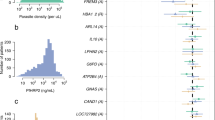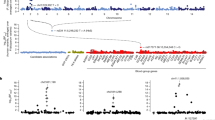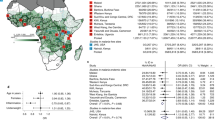Abstract
Cyclooxygenase-2 [(COX-2) or prostaglandin endoperoxide H2 synthase-2 (PTGS-2)] induces the production of prostaglandins as part of the host-immune response to infections. Although a number of studies have demonstrated the effects of COX-2 promoter variants on autoimmune and inflammatory diseases, their role in malaria remains undefined. As such, we investigated the relationship between four COX-2 promoter variants (COX-2 −512 C > T, −608 T > C, −765 G > C, and −1195 A > G) and susceptibility to malaria and severe malarial anemia (SMA) upon enrollment and longitudinally over a 36-month follow-up period. All-cause mortality was also explored. The investigation was carried out in children (n = 1081, age; 2–70 months) residing in a holoendemic Plasmodium falciparum transmission region of western Kenya. At enrollment, genotypes/haplotypes (controlling for anemia-promoting covariates) did not reveal any strong effects on susceptibility to either malaria or SMA. Longitudinal analyses showed decreased malaria episodes in children who inherited the −608 CC mutant allele (RR = 0.746, P = 1.811 × 10−4) and -512C/-608T/-765G/-1195G (CTGG) haplotype (RR = 0.856, P = 0.011), and increased risk in TTCA haplotype carriers (RR = 1.115, P = 0.026). Over the follow-up period, inheritance of the rare TTCG haplotype was associated with enhanced susceptibility to both malaria (RR = 1.608, P = 0.016) and SMA (RR = 5.714, P = 0.004), while carriage of the rare TTGG haplotype increased the risk of malaria (RR = 1.755, P = 0.007), SMA (RR = 8.706, P = 3.97 × 10−4), and all-cause mortality (HR = 110.000, P = 0.001). Collectively, these results show that SNP variations in the COX-2 promoter, and their inherited combinations, are associated with the longitudinal risk of malaria, SMA, and all-cause mortality among children living in a high transmission area for P. falciparum.
This is a preview of subscription content, access via your institution
Access options
Subscribe to this journal
Receive 12 print issues and online access
$259.00 per year
only $21.58 per issue
Buy this article
- Purchase on Springer Link
- Instant access to full article PDF
Prices may be subject to local taxes which are calculated during checkout

Similar content being viewed by others
References
WHO. World Malaria Report 2018. WHO Report. Geneva: World Health Organization; 2018. ISBN 978-92-4-156565-3 Contract No.: Licence: CC BY-NC-SA 3.0 IGO
Amek NO, Van Eijk A, Lindblade KA, Hamel M, Bayoh N, Gimnig J, et al. Infant and child mortality in relation to malaria transmission in KEMRI/CDC HDSS, Western Kenya: validation of verbal autopsy. Malar J. 2018;17:37.
Obonyo CO, Vulule J, Akhwale WS, Grobbee DE. In-hospital morbidity and mortality due to severe malarial anemia in western Kenya. Am J Trop Med Hyg. 2007;77(6 Suppl):23–8.
Breman JG, Egan A, Keusch GT. The intolerable burden of malaria: a new look at the numbers. Am J Trop Med Hyg. 2001;64(1-2 Suppl):iv–vii.
Aidoo M, Terlouw DJ, Kolczak MS, McElroy PD, ter Kuile FO, Kariuki S, et al. Protective effects of the sickle cell gene against malaria morbidity and mortality. Lancet 2002;359:1311–2.
Davenport GC, Ouma C, Hittner JB, Were T, Ouma Y, Ong’echa JM, et al. Hematological predictors of increased severe anemia in Kenyan children coinfected with Plasmodium falciparum and HIV-1. Am J Hematol. 2010;85:227–33.
Otieno RO, Ouma C, Ong’echa JM, Keller CC, Were T, Waindi EN, et al. Increased severe anemia in HIV-1-exposed and HIV-1-positive infants and children during acute malaria. AIDS. 2006;20:275–80.
Were T, Davenport GC, Hittner JB, Ouma C, Vulule JM, Ong’echa JM, et al. Bacteremia in Kenyan children presenting with malaria. J Clin Microbiol. 2011;49:671–6.
Fendel R, Brandts C, Rudat A, Kreidenweiss A, Steur C, Appelmann I, et al. Hemolysis is associated with low reticulocyte production index and predicts blood transfusion in severe malarial anemia. PLoS ONE. 2010;5:e10038.
Perkins DJ, Were T, Davenport GC, Kempaiah P, Hittner JB, Ong’echa JM. Severe malarial anemia: innate immunity and pathogenesis. Int J Biol Sci. 2011;7:1427–42.
Anyona SB, Kempaiah P, Raballah E, Davenport GC, Were T, Konah SN, et al. Reduced systemic bicyclo-prostaglandin-E2 and cyclooxygenase-2 gene expression are associated with inefficient erythropoiesis and enhanced uptake of monocytic hemozoin in children with severe malarial anemia. Am J Hematol. 2012;87:782–9.
Perkins DJ, Kremsner PG, Weinberg JB. Inverse relationship of plasma prostaglandin E2 and blood mononuclear cell cyclooxygenase-2 with disease severity in children with Plasmodium falciparum malaria. J Infect Dis. 2001;183:113–8.
Dixon DA, Kaplan CD, McIntyre TM, Zimmerman GA, Prescott SM. Post-transcriptional control of cyclooxygenase-2 gene expression. The role of the 3’-untranslated region. J Biol Chem. 2000;275:11750–7.
Agard M, Asakrah S, Morici LA. PGE(2) suppression of innate immunity during mucosal bacterial infection. Front Cell Infect Microbiol. 2013;3:45.
Perkins DJ, Hittner JB, Mwaikambo ED, Granger DL, Weinberg JB, Anstey NM. Impaired systemic production of prostaglandin E2 in children with cerebral malaria. J Infect Dis. 2005;191:1548–57.
Perkins DJ, Moore JM, Otieno J, Shi YP, Nahlen BL, Udhayakumar V, et al. In vivo acquisition of hemozoin by placental blood mononuclear cells suppresses PGE2, TNF-alpha, and IL-10. Biochem Biophys Res Commun. 2003;311:839–46.
Kosaka T, Miyata A, Ihara H, Hara S, Sugimoto T, Takeda O, et al. Characterization of the human gene (PTGS2) encoding prostaglandin-endoperoxide synthase 2. Eur J Biochem. 1994;221:889–97.
Tazawa R, Xu XM, Wu KK, Wang LH. Characterization of the genomic structure, chromosomal location and promoter of human prostaglandin H synthase-2 gene. Biochem Biophys Res Commun. 1994;203:190–9.
Cipollone F. Cox-2 polymorphisms and cardiovascular disease: elucidating the hidden side of the disease. Atherosclerosis 2009;207:348–9.
Hakansson A, Bergman O, Chrapkowska C, Westberg L, Belin AC, Sydow O, et al. Cyclooxygenase-2 polymorphisms in Parkinson’s disease. Am J Med Genet B Neuropsychiatr Genet. 2007;144B:367–9.
Sakaki M, Makino R, Hiroishi K, Ueda K, Eguchi J, Hiraide A, et al. Cyclooxygenase-2 gene promoter polymorphisms affect susceptibility to hepatitis C virus infection and disease progression. Hepatol Res. 2010;40:1219–26.
Wang W, Fan X, Zhang Y, Yang Y, Yang S, Li G. Association between COX-2 polymorphisms and lung cancer risk. Med Sci Monit. 2015;21:3740–7.
Zhang X, Miao X, Tan W, Ning B, Liu Z, Hong Y, et al. Identification of functional genetic variants in cyclooxygenase-2 and their association with risk of esophageal cancer. Gastroenterology. 2005;129:565–76.
Prakash G, Umar M, Ajay S, Bali D, Upadhyay R, Gupta KK, et al. COX-2 gene polymorphisms and risk of chronic periodontitis: a case-control study and meta-analysis. Oral Dis. 2015;21:38–45.
Zhang L, Zhang Y, Zhang X, Hong B. Prostaglandin-endoperoxide synthase 2 (PTGS2) rs20417 polymorphism and prostate cancer risk: a meta analysis. Int J Clin Exp Med. 2015;8:20454–62.
Zhang MM, Xie X, Ma YT, Zheng YY, Yang YN, Li XM, et al. Association of COX-2 -765G>C genetic polymorphism with coronary artery disease: a meta-analysis. Int J Clin Exp Med. 2015;8:7412–8.
Wang Y, Jiang H, Liu T, Tang W, Ma Z. Cyclooxygenase-2- 1195G>A (rs689466) polymorphism and cancer susceptibility: an updated meta-analysis involving 50,672 subjects. Int J Clin Exp Med. 2015;8:12448–62.
Xu W, Huang Y, Zhang T, Zhao L, Fan J, Li L. Cyclooxygenase-2 gene polymorphisms and susceptibility to hepatocellular carcinoma: A meta-analysis based on 10 case-control studies. J Cancer Res Ther. 2018;14(Supplement):S105–S13.
Dai ZJ, Shao YP, Ma XB, Xu D, Tang W, Kang HF, et al. Association of the three common SNPs of cyclooxygenase-2 gene (rs20417, rs689466, and rs5275) with the susceptibility of breast cancer: an updated meta-analysis involving 34,590 subjects. Dis Markers 2014;2014:484729.
Liang Y, Liu JL, Wu Y, Zhang ZY, Wu R. Cyclooxygenase-2 polymorphisms and susceptibility to esophageal cancer: a meta-analysis. Tohoku J Exp Med. 2011;223:137–44.
Luo D, Long Y, Chen GJ. Cyclooxygenase-2 gene polymorphisms and risk of Alzheimer’s disease: a meta-analysis. J Neurol Sci. 2015;359:100–5.
Luo MX, Long BB, Li F, Zhang C, Pan MT, Huang YQ, et al. Roles of Cyclooxygenase-2 gene -765G>C (rs20417) and -1195G>A (rs689466) polymorphisms in gastric cancer: a systematic review and meta-analysis. Gene 2019;685:125–35.
Agundez JA, Blanca M, Cornejo-Garcia JA, Garcia-Martin E. Pharmacogenomics of cyclooxygenases. Pharmacogenomics 2015;16:501–22.
Papafili A, Hill MR, Brull DJ, McAnulty RJ, Marshall RP, Humphries SE, et al. Common promoter variant in cyclooxygenase-2 represses gene expression: evidence of role in acute-phase inflammatory response. Arterioscler Thromb Vasc Biol. 2002;22:1631–6.
Ong’echa JM, Keller CC, Were T, Ouma C, Otieno RO, Landis-Lewis Z, et al. Parasitemia, anemia, and malarial anemia in infants and young children in a rural holoendemic Plasmodium falciparum transmission area. Am J Trop Med Hyg. 2006;74:376–85.
Perkins DJ, Were T, Anyona S, Hittner JB, Kempaiah P, Davenport GC, et al. The Global Burden of Severe Falciparum Malaria: An Immunological and Genetic Perspective on Pathogenesis. Dynamic Models of Infectious Diseases: Springer; 2013. p. 231–83.
Bloland PB, Boriga DA, Ruebush TK, McCormick JB, Roberts JM, Oloo AJ, et al. Longitudinal cohort study of the epidemiology of malaria infections in an area of intense malaria transmission II. Descriptive epidemiology of malaria infection and disease among children. Am J Trop Med Hyg. 1999;60:641–8.
WHO. Severe falciparum malaria. World Health Organization, Communicable Diseases Cluster. Trans R Soc Trop Med Hyg. 2000;94(Suppl 1):S1–90.
Liu YT, Old JM, Miles K, Fisher CA, Weatherall DJ, Clegg JB. Rapid detection of alpha-thalassaemia deletions and alpha-globin gene triplication by multiplex polymerase chain reactions. Br J Haematol. 2000;108:295–9.
Hsu J, Fink D, Langer E, Carter ML, Bengo D, Ndidde S, et al. PCR-based allelic discrimination for glucose-6-phosphate dehydrogenase (G6PD) deficiency in Ugandan umbilical cord blood. Pediatr Hematol Oncol. 2014;31:68–75.
Gaunt TR, Rodriguez S, Zapata C, Day IN. MIDAS: software for analysis and visualisation of interallelic disequilibrium between multiallelic markers. BMC Bioinf. 2006;7:227.
Team RC. R: A language and environment for statistical computing. R Foundation for Statistical Computing V, Austria. 2016. URL http://www R-project org. 2018.
Hosking L, Lumsden S, Lewis K, Yeo A, McCarthy L, Bansal A, et al. Detection of genotyping errors by Hardy-Weinberg equilibrium testing. Eur J Hum Genet. 2004;12:395–9.
Kwiatkowski DP, Luoni G. Host genetic factors in resistance and susceptibility to malaria. Parassitologia 2006;48:450–67.
Ryg-Cornejo V, Ly A, Hansen DS. Immunological processes underlying the slow acquisition of humoral immunity to malaria. Parasitology 2016;143:199–207.
Eybpoosh S. Hardy Weinberg equilibrium testing and interpretation: focus on infection. J Med Microbiol Infect Dis. 2018;6:35–6.
Griffin JT, Hollingsworth TD, Reyburn H, Drakeley CJ, Riley EM, Ghani AC. Gradual acquisition of immunity to severe malaria with increasing exposure. Proc Biol Sci. 2015;282:20142657.
McElroy PD, ter Kuile FO, Hightower AW, Hawley WA, Phillips-Howard PA, Oloo AJ, et al. All-cause mortality among young children in western Kenya. VI: the Asembo Bay Cohort Project. Am J Trop Med Hyg. 2001;64(1-2 Suppl):18–27.
Snow RW, Omumbo JA, Lowe B, Molyneux CS, Obiero JO, Palmer A, et al. Relation between severe malaria morbidity in children and level of Plasmodium falciparum transmission in Africa. Lancet 1997;349:1650–4.
Otieno F, Omolo C Infant and Child Mortality. Kenya Demographic and Health Survey 2003. Calverton, Maryland: 2004.
Acknowledgements
We gratefully acknowledge the assistance of the University of New Mexico-Kenya team: Nicholas Otieno Ondiek, Vincent Odhiambo Otieno, Anne A Ong’ondo, Chrispine Wasonga Ochieng, Everlyne A Modi, Joan L A Ochieng, Jacob Oyoko Odeny, Joseph Oduor, Martin Ogalo, Moses Ebungure, Moses Lokorkeju, Rodney B Mongare, Stella Mariz Akinyi Oloo and Vincent Omanje. We are also grateful to all of the parents, guardians, and children who participated in the study. The content is solely the responsibility of the authors and does not represent the official views of the funding agencies. The content is solely the responsibility of the authors and the funders did not have any role in study design, data collection, data analysis, interpretation, or writing of the report. The work was supported by National Institutes of Health (NIH) Research Grants R01AI130473 and R01AI51305 (DJP), NIH Fogarty International Center Grants D43TW05884 (DJP, SBA) and D43 TW010543 (SBA, DJP), and LANL-LDRD 20150090DR (BHM, DJP).
Author information
Authors and Affiliations
Corresponding author
Ethics declarations
Conflict of interest
The authors declare that they have no conflict of interest.
Additional information
Publisher’s note Springer Nature remains neutral with regard to jurisdictional claims in published maps and institutional affiliations.
Rights and permissions
About this article
Cite this article
Anyona, S.B., Hengartner, N.W., Raballah, E. et al. Cyclooxygenase-2 haplotypes influence the longitudinal risk of malaria and severe malarial anemia in Kenyan children from a holoendemic transmission region. J Hum Genet 65, 99–113 (2020). https://doi.org/10.1038/s10038-019-0692-3
Received:
Revised:
Accepted:
Published:
Issue Date:
DOI: https://doi.org/10.1038/s10038-019-0692-3
This article is cited by
-
Human NCR3 gene variants rs2736191 and rs11575837 alter longitudinal risk for development of pediatric malaria episodes and severe malarial anemia
BMC Genomics (2023)
-
Genetic variation in CSF2 (5q31.1) is associated with longitudinal susceptibility to pediatric malaria, severe malarial anemia, and all-cause mortality in a high-burden malaria and HIV region of Kenya
Tropical Medicine and Health (2022)



